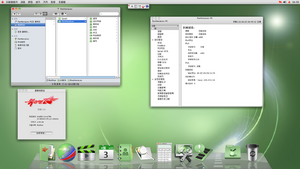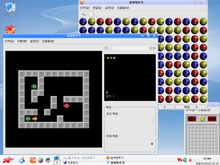Software:Red Star OS
 | |
 Screenshot of the desktop of Red Star OS 3.0, localized with North Korean terminology and spelling | |
| Developer | Korea Computer Center, North Korea |
|---|---|
| OS family | Linux (desktop and server), Android (on Woolim, Arirang, Samjiyon, Manbang, Jindallae and Ryonghung)[1][2][3] |
| Working state | Current |
| Source model |
|
| |Final release|Latest release}} | 4.0 |
| Marketing target | Personal computers |
| Available in | Korean |
| Platforms | IA-32, x86-64 (server only), ARM (mobile and tablet only) |
| Kernel type | Monolithic forked from (Linux kernel) |
| Influenced by | Fedora Linux (desktop), CentOS (Server), Android (mobile and tablet)[4] |
| Default user interface | KDE[5] |
| License | GPL (Linux kernel and other GNU software only), Proprietary |
Red Star OS (Korean: 붉은별; MR: Pulgŭnbyŏl) is a North Korean Linux distribution, with development first starting in 1998 at the Korea Computer Center (KCC). Prior to its release, computers in North Korea typically used Red Hat Linux,[6] and later switched to modified versions of Microsoft Windows with North Korean language packs installed.[7]
Version 3.0 was released in the summer of 2013, but (As of 2014), version 1.0 continues to be more widely used.[verification needed] It is offered only in a Korean language edition, localized with North Korean terminology and spelling.[8]
Specifications
Red Star OS features a modified Mozilla Firefox browser called Naenara ("My country" in Korean), which is used for browsing the Naenara web portal on North Korea's national intranet known as Kwangmyong. Naenara comes with two search engines. Other software includes a text editor, an office suite, an e-mail client, audio and video players, a file sharing program, and video games.[9][10][11] Version 3, like its predecessors, utilizes Wine, a compatibility layer that allows Windows programs to be run under Linux.[12]
The operating system utilizes customized versions of KDE Software Compilation. Earlier versions had KDE 3-based desktops. Version 3.0 closely resembles Apple's macOS, whereas previous versions more closely resembled Windows XP;[13][14] current North Korean leader Kim Jong-un was seen with an iMac on his desk in a 2013 photo, indicating a possible connection to the redesign.[15][16][17]
| System requirements | ||||||||||
|---|---|---|---|---|---|---|---|---|---|---|
| ||||||||||
Media attention

The Japan-based North Korea-affiliated newspaper Choson Sinbo interviewed two Red Star OS programmers in June 2006.[6] English-language technology blogs, including Engadget and OSnews, as well as South Korean wire services such as Yonhap, went on to repost the content.[8][20][21] In late 2013, Will Scott, who was visiting the Pyongyang University of Science and Technology, purchased a copy of version 3 from a KCC retailer in southern Pyongyang, and uploaded screenshots to the internet.[12]
In 2015, two German researchers speaking at the Chaos Communication Congress[22] described the internal operation of the OS.[23] The North Korean government wants to track the underground market of USB flash drives used to exchange foreign films, music and writing,[24] so the system watermarks all files on portable media attached to computers.[25]
History
Version 1.0/Beta


The first version appeared in 2008. It is very reminiscent of the Windows XP operating system.
It featured the "Naenara" web browser, based on Mozilla Firefox, and an Office suite based on Open Office, called "Uri 2.0". Wine is also included.
One copy has been leaked online. The screenshots of the operating system were officially published by KCNA and discovered by South Korean news sites.[11]
Version 2.0

The development of version 2.0 began in March 2008, and was completed on June 3 2009. Like its predecessor, its appearance resembles Windows XP, and was priced at 2000 North Korean won (approx. US$15).
The "Naenara" internet browser is also included in this version. The browser was released on 6 August 2009, as part of the operating system, and was priced at 4000 North Korean won (approx. US$28).
The operating system uses a special keyboard layout that differs greatly from the South Korean standard layout.[citation needed]
Version 3.0


Version 3.0 was introduced on April 15, 2012, and its appearance resembles macOS operating systems of various versions.[26] The new version supports both IPv4 and IPv6 addresses.
The operating system comes pre-installed with a number of applications that monitor its users. If a user tries to disable security functions, an error message will appear on the computer, or the operating system will crash and reboot. In addition, a watermarking tool integrated into the system marks all media content with the hard drive's serial number, allowing the North Korean authorities to trace the spread of files. The system also has hidden "antivirus" software that is capable of removing censored files that are remotely stored by the North Korean Secret Service. There is a user group called "administrator" in the operating system. Users do not have root access by default, but are able to elevate their privileges to root by running a built-in utility called "rootsetting". However, provisions are made in kernel modules to deny even root users access to certain files, and extensive system integrity checks are done at boot time to ensure these files have not been modified.[22]
Red Star OS 3 comes with a customized version of OpenOffice called Sogwang Office.[22]
The operating system was leaked by Zammis Clark ("SlipStream").[27]
Version 4.0
Little information is available on version 4.0.
According to The Pyongyang Times, an official version of Red Star OS 4.0 had been developed by January 2019, with full network support as well as system and service management tools.[28]
In June and July 2020, South Korea 's NKEconomy (NK경제) obtained a copy of Red Star OS 4.0 and have published articles about it.[29][30][31][32]
Vulnerabilities
In 2016, the computer security company Hacker House found a security vulnerability in the integrated web browser Naenara. This vulnerability makes it possible to execute commands on the computer if the user clicks on a crafted link.[33][34]
References
- ↑ "Domestic Tablet" (in en-US). NKNews. https://www.nknews.org/2017/05/north-korean-company-advertising-domestically-made-ipad/.
- ↑ "Domestic Tablet" (in en-US). NKNews. https://www.techtimes.com/articles/190872/20161231/north-koreas-android-tablet-woolim-is-packed-with-features-automatic-screenshots-non-removable-bloatware-and-more.htm.
- ↑ "North Korean Smartphone" (in en-US). Mashable. https://mashable.com/article/north-korean-smartphone.
- ↑ "Inside North Korea's Totalitarian Operating System" (in en-us). 27 December 2015. https://motherboard.vice.com/en_us/article/wnx8yy/inside-north-koreas-totalitarian-operating-system.
- ↑ "Red Star OS" (in en-US). ArchiveOS. https://archiveos.org/redstar/.
- ↑ 6.0 6.1 Kim, Chi-yong (2006-06-21), "〈민족정보산업의 부흥 -상-〉 《우리식 콤퓨터조작체계(OS) 》의 개발과 도입" (in ko), Choson Sinbo, http://www.korea-np.co.jp/news/ViewArticle.aspx?ArticleID=22248
- ↑ "North Korea's 'paranoid' computer operating system revealed" (in en). The Guardian. 27 December 2015. https://www.theguardian.com/world/2015/dec/27/north-koreas-computer-operating-system-revealed-by-researchers.
- ↑ 8.0 8.1 Nam, Hyeon-ho (2010-03-03), (in ko)Yonhap News, http://media.daum.net/digital/view.html?cateid=1068&newsid=20100302174815619&p=yonhap, retrieved 2013-01-23
- ↑ "Naenara: Exploring a North Korean Computer & Internet". November 20, 2019. https://koryogroup.com/blog/naenara-exploring-a-north-korean-computer-internet.
- ↑ Locker, Theresa (January 7, 2015). "You Can Now Install the Original North Korean Operating System RedStar 3.0". Vice News. https://www.vice.com/en/article/pgaxa9/you-can-now-install-the-north-korean-operating-system-redstar-30.
- ↑ 11.0 11.1 Tong-hyung, Kim (5 April 2010). "NK Goes for Linux-Based Operating System". The Korea Times. http://www.koreatimes.co.kr/www/news/biz/2010/04/123_63669.html.
- ↑ 12.0 12.1 Williams, Martyn (January 31, 2014). "North Korea's Red Star OS Goes Mac". Martyn Williams. http://www.northkoreatech.org/2014/01/31/north-koreas-red-star-os-goes-mac/.
- ↑ "Apple's Mac OSX imitated in latest North Korea system" (in en-GB). BBC News. 2014-02-05. https://www.bbc.com/news/technology-26047439.
- ↑ "North Korean computers get 'Apple' makeover" (in en). Telegraph.co.uk. https://www.telegraph.co.uk/technology/apple/10619703/North-Korean-computers-get-Apple-makeover.html.
- ↑ "Apple's Mac OS X imitated in latest North Korea system". BBC News. 2014-02-05. https://www.bbc.co.uk/news/technology-26047439.
- ↑ "North Korean computers get 'Apple' makeover". The Daily Telegraph. 5 February 2014. https://www.telegraph.co.uk/technology/apple/10619703/North-Korean-computers-get-Apple-makeover.html.
- ↑ "North Korean computers get iMac makeover". Business Insider. https://www.businessinsider.com/blue-sky-north-korea-computer-resembles-an-imac-2015-6?r=US&IR=T.
- ↑ "A Visual Guide To North Korea's Totalitarian Operating System" (in en-US). Fast Company. 2014-09-23. https://www.fastcompany.com/3036046/what-its-like-to-use-north-koreas-red-star-os.
- ↑ "North Korea's Red Star OS takes the 'open' out of 'open source'". 4 March 2010. https://www.engadget.com/2010/03/04/north-koreas-red-star-os-takes-the-open-out-of-open-source/.
- ↑ Holwerda, Thom (2009-03-04), "North Korea Develops Its Own Linux Distribution", OSNews, http://www.osnews.com/story/22960/North_Korea_Develops_Its_Own_Linux_Distribution, retrieved 2013-01-23
- ↑ Flatley, Joseph L. (2009-03-04), "North Korea's Red Star OS takes the 'open' out of 'open source'", Engadget, https://www.engadget.com/2010/03/04/north-koreas-red-star-os-takes-the-open-out-of-open-source/, retrieved 2013-01-23
- ↑ 22.0 22.1 22.2 Florian Grunow; Niklaus Schiess (2015-12-28). Lifting the Fog on Red Star OS - A deep dive into the surveillance features of North Korea's operating system. Chaos Communication Congress 32.
- ↑ Jeremy Wagstaff and James Pearson (27 December 2015). "Paranoid: North Korea's computer operating system mirrors its political one". Reuters. https://www.reuters.com/article/northkorea-computers-idUSKBN0UA0GF20151227.
- ↑ James Pearson (27 March 2015). "The $50 device that symbolizes a shift in North Korea". Reuters. https://www.reuters.com/article/us-northkorea-change-insight-idUSKBN0MM2UZ20150327.
- ↑ "RedStar OS Watermarking". Insinuator. 16 July 2015. https://www.insinuator.net/2015/07/redstar-os-watermarking/.
- ↑ Williams, Martyn (2014-12-30). "Red Star 3.0 Desktop finally becomes public". https://www.northkoreatech.org/2014/12/30/red-star-3-0-desktop-finally-becomes-public/.
- ↑ "r/linux - I managed to get a hold of the latest version of that North Korean Linux distro, in some shape or form. Here's a torrent of Red Star OS 3.0 Server." (in en-US). 2 June 2014. https://www.reddit.com/r/linux/comments/272zxf/i_managed_to_get_a_hold_of_the_latest_version_of/.
- ↑ "The Pyongyang Times". http://www.pyongyangtimes.com.kp/pdf/2019/02/6.pdf.
- ↑ "북한 붉은별4.0에 오라클 버추얼박스를 탑재하고 있다". NK경제 (NKEconomy). 2020-06-15. http://www.nkeconomy.com/news/articleView.html?idxno=3191.
- ↑ "붉은별4.0 서광 오피스에서 MS워드 파일 편집 가능하다". NK경제 (NKEconomy). 2020-06-23. http://www.nkeconomy.com/news/articleView.html?idxno=3213.
- ↑ "북한 붉은별 4.0의 기본 브라우저는? 파이어폭스". NK경제 (NKEconomy). 2020-07-06. http://www.nkeconomy.com/news/articleView.html?idxno=3261.
- ↑ "붉은별4.0의 비밀번호 관리는 키체인으로?". NK경제 (NKEconomy). 2020-07-21. http://www.nkeconomy.com/news/articleView.html?idxno=3292.
- ↑ "RedStar OS 3.0: Remote Arbitrary Command Injection". https://www.myhackerhouse.com/redstar-os-3-0-remote-arbitrary-command-injection/.
- ↑ Wei, Wang. "North Korea's Linux-based Red Star OS can be Hacked Remotely with just a Link" (in en-US). The Hacker News. https://thehackernews.com/2016/12/redstar-north-korea.html.
External links
- "OS "Red Star" - линуксоиды всех стран, соединяйтесь!" (in ru). 2010-02-27. http://ashen-rus.livejournal.com/4300.html.
- "Download"
- "North Korean Red Star operating system details emerge". BBC News. 2010-04-06. http://news.bbc.co.uk/2/hi/technology/8604912.stm.
- "Error: no
|title=specified when using {{Cite web}}" (in ko). 5 April 2010. http://www.yonhapnews.co.kr/economy/2010/04/03/0303000000AKR20100403065200017.HTML. - redstar-tools: A tool used for analyzing the system.
 |
